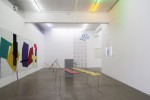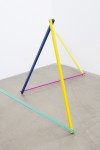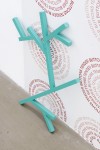RADU COMȘA
Things As They Are
- the kind of show made by squeezing modern thoughts into a tight space -
January 20th - February 18th, 2012
When Giorgio Vasari wrote the "Life of Artists", the notion of the authorship was finally acknowledged in the field of visual art. It was being used for quite some time previously, but never before had it been so clearly defined.
Since then, authorship has become more and more connected to branding and marketing, and the trend is going towards a point when they will have become indistinguishable. I don’t mean to demonize these concepts. Yet, we would be blind if we ignored the fact that nowadays artists are compelled to build their own brand, that above everything else they need to nest into a style, which is something familiar, repeated and recognizable. In other words, they have to brand themselves.
The whole notion of the “death of the author” didn’t really damage this status quo. On the contrary, it added strength to the idea of authorship. The artists have thus survived their own artistic death. Still, it is clear that they have simultaneously turned themselves into products of the capitalist society, much like Coca-Cola or the one dollar bill.
Everyday, Radu Comșa is fighting his way out of the aforementioned scenario. His work – or rather his modus operandi, his life style – is continuously contradicting the situation I just described. The fact that he has been working in the city of Cluj - with its cozy little coterie where everybody peeks at each other's work - didn’t help much.
With his last show at Sabot (“Being Radu Comșa”, 2010), the artist tried to find a solution through Catharsis. His drama is the apparent lack of consistency. He is not able to stick to a genre. Relentless curiosity turned him into an anti-artist par excellence, a ”loser”, an artist who never allowed himself to get shrunk to a brand.
But this is why I am here writing about his work. Whenever I visit his studio, I feel I am going to put into question the foundation of my understanding of visual art. I have to set myself free, free from the rules dominating my activities as a visual art professional, and the foundation of my beliefs, and what visual art is, means and stands for. Every visit at Radu's studio is like an epiphany.
Since he moved his studio in the Paintbrush Factory, I’ve noticed that he hung an object he had found in the building. I have never dared to ask him what it is, I just know it is something special for him and therefore for me as well.
That object – a series of colorful round compositions, perhaps a palette for industrial materials within a consumed frame – was an amulet, a talisman of sorts, and I knew it would eventually become the starting point for one of the many lives of Radu Comșa the anti-artist, the unsuccessfully-branded artist who was killed by his own curiosity, by his desire to experiment, by his lack of cynicism.
In fact, what Radu Comșa is doing now is completely different from what people used to associate him with and, on a larger scale, from the branded products of the so-called Cluj School. No more figuration, no more gray palette, no more history in the painting.
I don’t know whether it’s that object which finally took control of his ”schizophrenic” mind, or maybe it is the influence of his former teacher Florin Maxa, who just started to show his work with Sabot. I just know that the new collection of works he will be presenting for his second solo show at the gallery are different, odd and exciting.
For this new show, the anti-artist has created a series of abstract three-dimensional shapes made out of wood. He is combining and then painting in accordance to his mantra: “Must replicate the industrial production.” Even the colors he makes use of, such as pink, turquoise or yellow, are definitely reinforcing this style. He showed them to me in the gallery space in a way that made me think of Cadere but also of the notion of ”painting overall”, an expression I used for a show I co-organized in Prague.
Probably the ”painting overall”, or ”expanded painting” – which was the title of the show through which funnily enough I discovered his work alongside that of Adrian Ghenie and Șerban Savu – provides the key to understanding what direction Radu Comșa is trying to lead us to right now.
Over the last few years, he abandoned the use of figures in the subject of his painting in order to substitute them with structures: windows, hooks, pedestals, chairs, and so forth. Once these structures were covered in paint, he realized that the only way to redefine that role of color and shape in space was to stop painting them and start making them.
The process of creation alone explains how painterly these objects are. In the studio, he is putting a large canvas on the wall, the same way he used to do when he was doing figurative paintings. But instead of using the canvas as a painting, Radu Comșa turned it in a big palette, a neutral territory to test the colors he will then use to paint the object.
This reminds me of Ann Craven’s work, who always transformed the palette in a work in its own right and who believed that abstraction or figuration, painting on an object or painting “in space” were not really different, after all.
Radu Comșa's new exhibition is a true example of ”expanded painting”: thinking as a painter when you paint your fence, thinking as a painter when you match the color of your clothes, thinking as a painter when you mix the vegetables for your salad, thinking as a painter when you buy curtains for your house.
This summarizes the beginning of my journey into Radu Comșa’s new life as an anti-artist. Before a visit to his studio, he took me to the homeware department store and asked for suggestions about a curtain he wanted to buy. At the beginning I was a bit confused, but then I realized that buying things and painting has the exact same meaning for him.
This fluidity of thoughts and deeds permeates my life in a way which is difficult to understand even by myself. I am so imbued in it, that I don’t even see it. Radu Comșa's modus operandi opened a door towards my own self-analysis. That door has always been hidden from my view, camouflaged by the insignificance of daily occurrences and the apparent futility of mundane actions. With his work, Radu Comșa brought the fluidity of thoughts and deeds to my attention and I am sure that his approach will contribute to a new history, a new legacy and a new state of what we still call “painting” today.
I wish I could say more about his work but I must stop my journey here. Not because I would not like to continue, neither because there is nothing left to say, quite the opposite, actually. I must stop here because I’ve learnt that the moment you try to understand the work of Radu Comșa, the moment you think you know what he’s doing, you realize that he has already, elusively, moved somewhere else.
Conscious of this insatiable curiosity, which kills his presence as a brand but feeds his life as an artist, I must simply wait and see what comes next. (Marcel Janco)
Tel Aviv, January, 2012
.
photographs by Zoltán Gábri

















